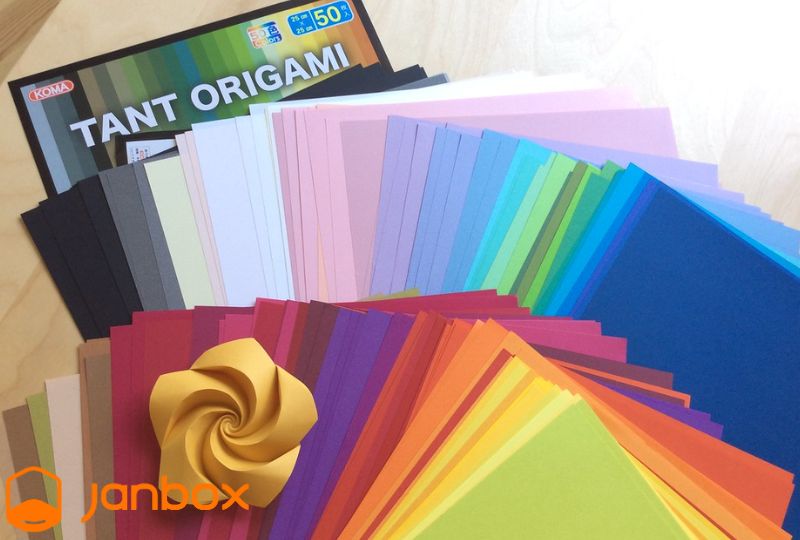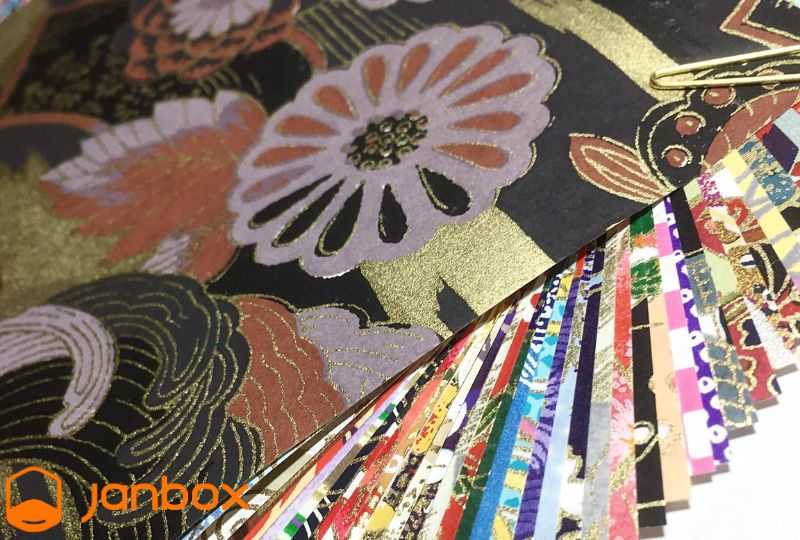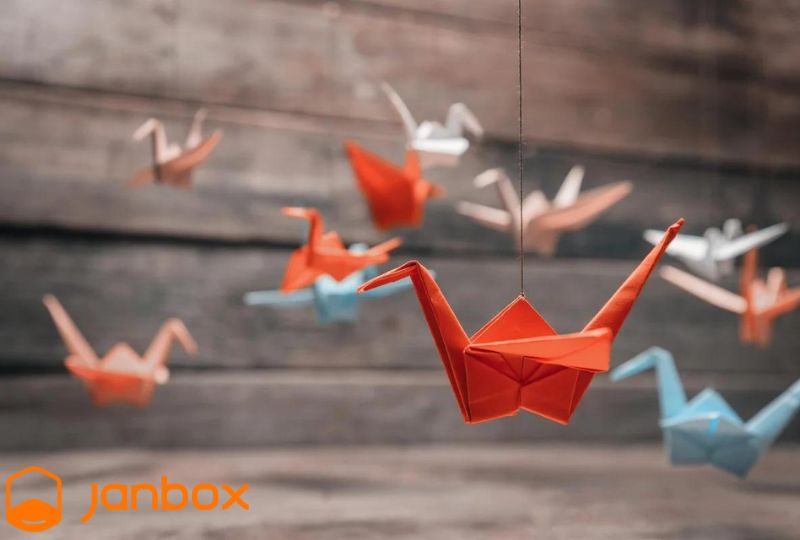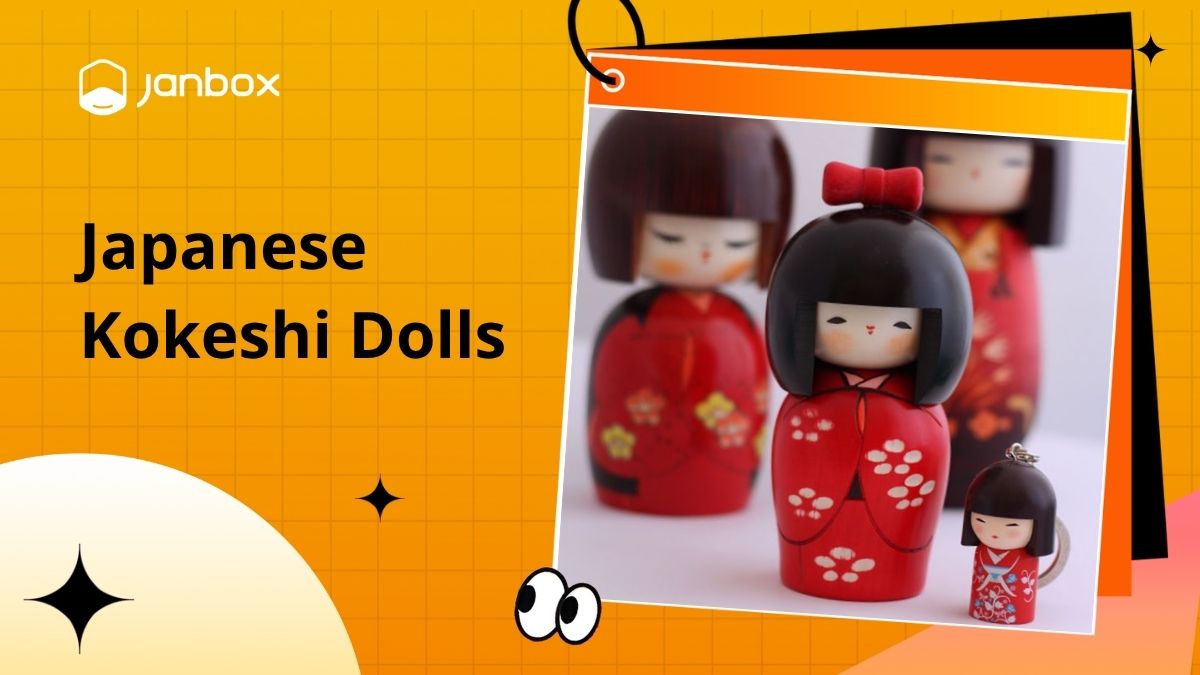Choosing the perfect origami paper types can significantly improve your folding experience and the quality of your work. With countless options out there, the decision can be difficult. This blog will walk you through six of the best origami paper options, providing useful insights to help you decide.
1. A Beginner’s Introduction to Origami Paper
This introduction will break down the essentials of origami paper for beginners, providing you with the knowledge about “What is origami paper and its history?”
1.1. What Is Origami?
Origami, a Japanese term composed of which means to fold, and “kami,” which means paper, is an art form that relies solely on folding techniques and avoids cuts, glue, or any marks. The objective is to convert a simple flat sheet into a final creation by employing folding and shaping skills.
Though origami is the best-known paper-folding technique, it may not be the first. Chinese art, with roots older than Japanese art, includes zhezhi, the Chinese tradition of paper folding, which might have been the initial form of this craft.
Among the most recognizable origami figures is the orizuru, a paper crane. The name is derived from “ori” which means to fold and “tsuru” which means crane, representing the Red-crowned Crane, a bird deeply respected in Japanese tradition. Paper art that involves cutting is referred to as kirigami, combining “kiru” (to cut) and “kami” (paper).
“Ori” means “fold” and “kami” means “paper”
1.2. The History Of Origami Paper
The history of Origami is shrouded in uncertainty, and there is no definitive agreement on its origins. Some experts theorize that origami originated in Japan around 1000 CE, though there is recorded proof of traditional Japanese paper folding from 1603 to 1867.
There is a perspective that links the beginnings of paper folding to Chinese art, particularly since paper is believed to have been first created in China during the Han Dynasty. Moreover, folding and burning paper became part of traditional rituals in China during the Song Dynasty and similarly in Japan during the Heian period.
As an example, origami butterflies were part of Shinto wedding ceremonies, symbolizing the bride and groom. This suggests that a form of ceremonial origami existed at the time, which may have paved the way for the evolution of zhezhi or origami.
The tradition of paper folding also extends to other East Asian cultures, like Korea, where it is called Jong-i jeobgi and forms a significant aspect of cultural education. Some experts suggest that paper folding originated from the techniques used in textile folding, such as pleating garments or napkin folding, and might have originated in Europe instead of Asia. While the specifics are uncertain, It is unequivocally clear that origami did not exist before 1600.
The history of origami is shrouded in uncertainty
2. The Origami Paper’s Meaning In Japanese Culture
Origami represents far more than a sheet of paper; it holds deep cultural significance in Japanese tradition. In this exploration, let’s uncover the symbolism and rich history about origami paper.
2.1. It teaches the value of accuracy and structure
When creating an origami pattern, each fold must be made precisely and in the right order; there is no room for error. Therefore, this talent is considerably more culturally relevant than just making because it is taught to kids at an early age. The Japanese culture takes pride in teaching youngsters the connection between hard work and results, and origami paper does just that.

2.2. It preserves a section of Japanese history
You already understand that origami paper is related to Japan’s history unless you decided to skip it. Even if it’s not something that would be used on a daily basis, it’s crucial to pass on the language and practices of your ancestors in order to maintain your country’s heritage.
2.3. It offers real advantages
Origami paper is really useful, and the Japanese are very practical people. We’ve already touched on some of these, so let’s quickly go through the highlights. Simple concepts like geometry can be taught to kids through the art of origami paper. Engineering may employ origami paper to create intricate products. Origami paper can be used to bring communities together to discuss important global concerns like peace. Origami has practical applications and is far from being “simply art,” which is appealing to Japanese sensibilities.
2.4. It has symbolism
Japanese origami artists frequently use folds that have deeper symbolic meanings. Looking at the swan designs used at weddings in the past; they signify the union of a couple. Consider the dragons, one of the most popular Japanese folds that stands for strength and knowledge. Obviously, you should also take a look at the cranes; when you gather a thousand of them, the globe is your oyster. Even though they are quite practical, the Japanese also place a lot of value on symbolism, and origami gives them the freedom to design whatever symbol suits the situation.
2.5. It is contemporary
Origami has evolved with the times, avoiding the stereotype of a stodgy handicraft stuck in the past. As a result, it can continue to be a vital aspect of Japanese culture. In Japanese classrooms, pupils are just about as probable to be folding a paper Pikachu because they’re a paper crane because modern origami has become cuter and cuter over time. Origami is a Japanese art form that isn’t likely to go out of style anytime soon due to its cultural importance, widespread appeal, and ongoing development.
>>> Read more: Findings Of Interest In The Omoshiroi Block
3. The Best Types Of Origami Papers

The fact about origami paper is all you need for origami is one factor in its popularity. It also actually makes little difference what brand of paper you choose, making it a fairly cheap hobby and pastime. The newspaper has been used by kids to create origami items since the days of our grandparents. Use recycled paper from previous adverts or glossy magazine pages instead.
But as you hone your craft, you’ll soon see that newspaper is lacking. Here, Japanese origami paper types are frequently used by individuals. One side of this paper is colored, and the other is white. It is offered commercially in packets, is reasonably priced, and – best of all – comes in pre-cut squares. For a few dollars, you can get convenience and fantastic color. Your paper must be able to resist repeated folds and unfolds for more complex origami sculptures. Tensile strength is necessary for it to resist ripping readily. You might occasionally wish for thicker paper to give your model volume and supple curves.
3.1. Washi
Long plant fibers are used to make the traditional Japanese paper known as washi or textured Origami paper. This essay has a distinctly Japanese feel to it. Japanese experts who have been handing down their experience for decades specifically designed it. It typically feels like cotton and is quite light. A variety of hues are available in fifty-sheet packets of washi paper. The thickness of each sheet ranges from 0.094 to 0.1 millimeters, making them thicker than standard papers but not as thick as Tant.

Washi origami paper, which you may wet-fold, is a thin and sturdy paper due to its long threads and shortage of glue. The delicate texture of Washi makes models that are folded with it look a little more realistic. Washi paper comes in many lovely packages, including this sizable box of 40 pages or a blue Yuzen packet.
Features:
- Washi is incredibly robust and long-lasting.
- This paper is of the highest caliber.
- It comes in quite lovely and distinctive Japanese-style patterns.
- Since washi is relatively thick, folding it can be a little more challenging, especially for intricate shapes.
- The cost of this article may be slightly higher than average.
3.2. Kami Paper
The most popular and widely used type of origami is likely kami. Typically, it has a smooth texture, solid color or motif on the front, and a white back. Kami is available in a wide array of different colors and patterns and is often relatively thin, weighing about 60 to 63 gsm. These squares of paper, which are typically 15 cm x 15 cm, can be utilized for practically any type of origami. In Japanese, “kami” is the word for paper.
Duo Kami, which is similar to standard kami but has a different color on either side, is another option. Both sides are various colors, as opposed to one color on the exterior and white back. Kami is the greatest origami, making it ideal for casual and beginning folds. Kami began her career in Japan in establishments with a long history and workers who had spent years honing their profession.

They start with white base paper, depending on the origami paper Japanese type they are making, and add different colors and designs by inking or imprinting them on the paper. This origami paper’s dual color and white sides are one of its distinctive qualities. A pure white paper or a normal sheet without any colors has a thickness of roughly 0.066 millimeters. Comparatively, the thickness of the colored side is about 0.071 millimeters.
Features:
- Kami is quite simple to use and holds creases very well.
- It is affordable and available in large quantities (500+ pages at a time).
- Perfect for casual folding, beginners, and models at the simple or intermediate level.
- Obtainable in a big selection of hues and patterns.
- Iti isn’t very high quality and typically only comes in squares measuring 15cm by 15cm. You’ll need larger and better paper whether you’re folding anything extremely complicated.
- You will not be disappointed with kami if you’re finding the ideal material for newbies or casual folding.
3.3. Tant Paper
Tant, which means a lot, can be translated as a lot of colors or vivid hues. Tant paper for origami has gained popularity in the world of Japanese origami. It is a vibrant fiber paper that retains its shape even after numerous folds and has a good surface texture. Tant sheet is only made by one paper mill company, and it is solely based in Japan.
This style of origami piece is arguably the most adaptable. Tant sheets can be utilized to fold a wide variety of shapes, from the most basic to the most intricate. This paper has a gorgeous patterned texture and a nice sheen. Tant paper is thicker than standard sheets, with a sheet thickness of about 0.118 millimeters. The paper is firm and has a finely textured surface. There are numerous color selections and it typically appears in a single color that is identical on both sides.

Tant paper, which is the second most popular type of origami paper after the standard type, is without a doubt the most widely used among origami folders. Tant paper origami is featured in a number of event exhibitions of origami crafts. While waiting, you can exercise with the less expensive paper used for normal everyday origami. To put it differently, Tant paper costs more than standard origami paper, however, it will improve the appearance of your creations.
Features:
- Because of its flexibility, this paper keeps folds and forms quite well.
- There are a plethora of various colors, and the color doesn’t deteriorate with time.
- It’s incredibly simple to paint or use ink to color one face on paper.
- Tant paper is available in various sizes: 7.5cm x 7.5cm, 110cm x 80cm.
- Wet folding works incredibly nicely with this paper.
- The paper’s texture reflects the light pretty well, making it a great subject for photographs. The models bowed in this substance appear fantastic in close-up photographs, and a camera flash doesn’t actually generate reflections.
- This origami paper does, however, tear quite readily, so use caution when folding.
- Only solid colors are available in tan. You’ll need to purchase different paper if you want patterns.
- Tant paper is simple to fold and is available in many colors and sizes, allowing you to fold just about anything, no regardless of how complex.
>>> Read more: Temari Balls: The Ultimate Guide Of Inspiring Ornamental Art From Japan
3.4. Tissue Foil Paper

One of the simplest sheets to employ for origami is tissue foil. It consists of both tissue paper and foil. Although the tissue gives it more nimble and attractive, the foil makes it sturdy and firm. Prior to this, only one way to obtain this paper was by laborious self-creation. It is fairly thin, at about 50 gsm. The foil portion of this paper is spangled, so it doesn’t reflect light and has a metallic appearance like conventional foil paper, which makes it intriguing.
Features:
- Due to its strength and thinness, this type of Japanese origami paper is one of the simplest to use.
- There are several different sizes available.
- Simple to extremely complicated sculptures can be folded using tissue foil.
- The foil makes it very simple to form curves as well as other 3D shapes, and it maintains creases quite well.
- There are just 9 different colors that are offered.
- This essay costs more than others.
- One of the best types of paper for origami is this one. Although there are just 9 colors available, they are all really attractive. You can curl anything because the foil portion isn’t glossy. Because it is so robust and thin, using it is also incredibly simple.
3.5. Chiyogami

A type of washi called chiyogami has traditional Japanese symbols etched on it. It contains a lot of bright patterns with touches of gold. Japanese Hina dolls made from this paper are a traditional craft. Chiyogami were once made by hand, but today they are typically produced by machines. It is available at specialty origami shops like Kim’s Crane and PaperJade.
3.6. Origamido
Origamido paper is often regarded as being as close to ideal as you can get by many different origami artists. This paper folds easily and is sturdy, crisp, and thin. It also takes a crease well. Richard Alexander and Michael LaFosse of the Origamido Studio handcrafted this paper. Each page is a distinct work of art.
It varies in weight up to 50 gsm. Being handmade, the origami paper’s thickness can differ between sheets. Other sizes are available, but 40 cm x 50 cm is the most typical size.

Features:
- This Origami Paper is quite simple to use and ideal for folding intricate sculptures.
- The paper has a stunning appearance.
- All items are handmade, so you can choose whatever color you like.
- The best origami paper users may buy is unquestionably this. In terms of thickness and strength, it much surpasses all other papers.
- It is normally exclusively offered at the Origamido workshop and is highly upscale.
- Additionally, this Origami Paper costs a great deal more than other types of paper.
- Although Origamido paper is fantastic, it is not recommended for everyday folding. When you’re folding anything extremely unique, you should use this paper.
4. 6 Things To Consider When Buying Origami Paper
Picking the appropriate origami paper types can significantly shape your folding experience and the visual appeal of your finished creation. Here are 6 essential factors to consider when selecting among various kinds of origami paper.
- Paper dimensions
- Prices of origami paper types
- Colors, patterns, and prints – many amazing origami paper types exist.
- Thickness – has a major influence on its foldability, tactile experience, and visual appeal.
- Texture of the paper – varies, with some being similar to standard printer paper, which is what we usually expect. Yet, some origami paper, especially handmade ones, can be rich, thick, and almost cloth-like. Additionally, heavily textured papers are also available.
- Fold and line retention – Foil origami paper is known for holding creases firmly, so the fold remains visible even after unfolding. Other papers, however, allow you to fold and unfold them without leaving creases behind.
Picking the right origami paper types can shape your folding experience
5. Where To Buy Origami Paper
Here are 3 well-known shopping websites where you can purchase high-quality items from Japan, including items not related to origami. In Japan, you can also visit stationery shops and choose the things by hand.
5.1. Amazon.com
Ordering origami pieces online is most likely the simplest and most practical at Amazon.com. They offer a sizable variety of standard papers, including Kraft, Kami, Tant, Washi, and Foil. If you consider where to buy origami paper, the next time you should order something from Amazon.com.

>>> Read more: How to Buy from Amazon Japan? A Guide for Non-Japanese Shoppers
5.2. Origami Shop
Another outstanding website where you can buy types of Japanese Origami paper is the Origami Shop website. The variety of these origami papers available is truly astonishing. Due to the site’s focus on origami, a number of the nicer paper is available there that is difficult to find elsewhere. They are the only true source of Origamido and tissue foil paper. The website is situated in France, and all of the pricing is in euros, however, it ships internationally and provides free shipping to many nations.
Free samples of other papers from Origami-Shop.com are also available, including Lokta, Tissue Foil, Kraft, and Elephant Hide. You may also try out a sample packet of 30 pieces with a selection of different kinds of paper from them.
5.3. Janbox
It’s possible to buy and sell one-of-a-kind handmade goods on Janbox, an online market site where individuals from all over the world can connect. Origami sheet from a wide variety of merchants is available there in a really fantastic assortment. Many really great patterns and colors that are exclusive to this store may be found here.
Janbox is a cross-border e-commerce application specializing in providing reliable order and purchasing services for goods from Japan and shipping them to Vietnam. When shopping through Janbox, you can freely search and select a wide range of domestic Japanese products with various categories and prices, as Janbox has direct connections with major Japanese e-commerce platforms such as Amazon Japan, Mercari, Rakuten, Yahoo Japan, and more.

For origami paper products, you can order directly through Janbox by following these steps:
- Step 1: Access the website https://janbox.com or download the Janbox application. Then, register an account and log in to start the shopping process.
- Step 2: Search for the product by entering its name in the search bar or browsing through product categories.
- Step 3: Choose the product that suits you. Carefully review the product description, price, seller information, shipping details, and more.
- Step 4: Place your order and proceed with the first payment, which includes the product price and proxy buying fee.
- Step 5: After Janbox purchases and delivers the item to their warehouse, proceed with the second payment, which includes the shipping fee and any additional service fees if applicable.
Janbox helps you buy authentic Japanese origami paper at the best prices and receive them in Vietnam within just 7-10 days, ensuring genuine products.
6. FAQs
Let’s explore some frequently asked questions to uncover the secrets behind different origami paper types.
6.1. What Origami Paper Types Are Most Commonly Used?
For the question “What is the best origami paper“, the best choice is kami, known for its smooth, thin texture and easy folding ability. Other popular types are washi, made from Japanese rice paper, scrapbooking paper, and special origami sheets that feature different patterns and colors.
6.2. Is Traditional Paper The Optimal Choice For Folding Origami Figures?
Traditional paper can be used, though it is not always the best paper for origami. Origami paper, being thinner and more flexible, simplifies folding and helps achieve sharper curves and more precise shapes.
6.3. Where To Buy Origami Paper?
Different types of origami paper are sold at stationery outlets, crafts and arts stores, and online on e-commerce platforms or sites specializing in origami. You can also use intermediaries such as Janbox to connect with Japanese stores for a wider range of options.
6.4. Is It Possible To Find Origami Paper That Is Sustainable And Eco-Friendly?
Yes, there are sustainable choices for origami paper types. Recycled paper or plant-fiber origami paper is more sustainable, and some stores even offer options with eco-certificates to ensure environmental responsibility.
6.5. What Factors Should Be Considered When Choosing Origami Paper?
Important factors to consider when choosing among origami paper types include size, cost, colors and patterns, thickness, texture, and the ability to hold folds and creases.
>>> Read more: How to buy from Japan – Janbox proxy shopping service
Conclusion
Though the best origami paper types provide a solid base for your journey, the world of origami paper is expansive and varied. Feel free to try new options and experiment with different techniques. Also, make sure to visit Janbox to place your order and start your exciting origami adventure.
Website: https://janbox.com
Email: [email protected]









